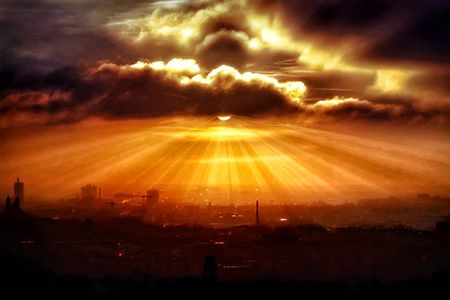 Acts 15:1-2, 22-29
Acts 15:1-2, 22-29
 Revelation 21:10-14, 22-23
Revelation 21:10-14, 22-23
 John 14:23-29
John 14:23-29
As we come close to the end of the Easter season, we have a great privilege to read the final chapters of the Book of Revelation in our second reading. Interestingly, though it is categorized as an apocalyptic scripture, it does not forecast disasters or events that may end the world. ‘Apocalypse’ in Greek, "apokálypsis", actually means “unveiling”. The book is revealing to us something of great significance which has been previously hidden but now is fully disclosed. Let us unpack this journey a little bit further.
John the visionary sees a city coming down from heaven to earth as a gift (Ref. Rv 21:10). Please notice that people are not escaping up to heaven, instead grace is coming down from heaven to take its place on earth. In the climax of the story, God does not destroy the earth, nor facilitates an escape of humanity from it, contrarily He renews it and establishes His order in it. What we hear about the divine kingdom has finally arrived, to a rightly ordered community under the lordship of God, in the midst of renewed heaven and earth. That is the Biblical vision. Please also note that the city itself is not individualistic but "communitarian", in which what God establishes for us is a community of love.
Then, John sees "a massive, high wall, with twelve gates where twelve angels were stationed and on which names were inscribed, the names of the twelve tribes of the Israelites" (Rv 21:12). Why would both “walls” and “gates” being emphasized here? Walls stand for identity. Israel’s identity as God’s chosen people is to live in communion with Him, worshipping Him and listening to His commandments. Gates stand for access. Israel is meant not for itself, but meant to be the "magnet" for all the nations, by which the world is gathered unto God. All these represent the fulfilment of Israel's mission; to be a gathering place of the world, a place in which all the nations orient toward God.
What follows is most important, in which John sees "no temple in the city, for temple is the Lord God almighty, and the lamb" (Rv 21:22). In ancient Israel, earthly Jerusalem was the temple. This reminds us of David who has brought the Ark of the Covenant into its capital city, and later on, his son Solomon, built the great temple to house the Ark, and that temple and its successors have lasted for a thousand years. It was the meeting place of heaven and earth, and where the right praise of Israel was on display. In this context, why would John see no temple in this new Jerusalem? This is because what he sees is a magnificent vision, in which the city itself has become a temple, that is to say "a place of right praise." The temple is not turning onto itself, but rather to sanctify the whole world, to turn the whole world into a temple! This is the climax and the fulfilment of the Biblical story.
Finally, John concludes, "The city has no need of sun or moon to shine on it, for the glory of God gave it light" (Rv 21:23). How splendid and marvelous it is! What God always wants from the beginning, is to shine light of His love into every city, every place, and every corner of our lives. In today's atheistic culture, however, we allow this light to extinguish all together. No, we need to allow the divine love to shed its light everywhere, and in all things. We need to turn the whole city into a holy temple. That is the whole "trajectory" of the whole Bible. That is what John sees in its fulfilment and realization of this great hope!
Let this passage in the Book of Revelation sinks into our heart once again, and let us read this in a meditative spirit, realizing that it is God’s great story reaching its fulfillment in its telling.
Acknowledgement
This is an excerpt from Bishop Robert Barron’s homilies, including
“No Temple in the New Jerusalem”, and “Apokalypsis”. For more information, please visit WordOnFire.org.
